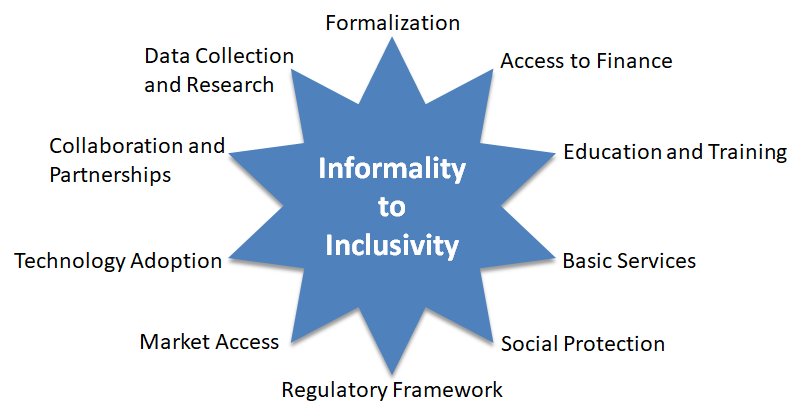 The Informal Sector

The informal economy plays a vital role in the socioeconomic fabric of many developing countries, providing livelihoods for a significant portion of the population. However, it is often characterized by challenges such as limited access to finance, lack of social protection, and inadequate infrastructure. To harness the potential of the informal sector and unlock its contributions to economic growth, it is crucial to implement effective strategies for its improvement and integration into the formal economy. This paper explores ten key strategies that have been employed by developing countries worldwide to address these challenges and promote the growth and integration of the informal economic sector. From formalization and access to finance to education and training, infrastructure development, social protection, regulatory reforms, market access, technology adoption, collaboration and partnerships, and data collection and research, these strategies offer a comprehensive framework for supporting informal businesses and unlocking their potential. By examining successful case studies and best practices, this paper aims to provide valuable insights for policymakers, practitioners, and researchers seeking to understand and enhance the informal sector's role in sustainable development. Defining the Informal Sector The informal sector refers to a segment of economic activities that operates outside the scope of formal regulations, structures, and protections. It encompasses a diverse range of economic activities, typically characterized by a lack of legal recognition, limited access to formal financial systems, and minimal government oversight. The informal sector is often associated with self-employment, small-scale businesses, and informal employment arrangements. In the informal sector, economic activities are predominantly carried out by individuals or small enterprises, often with limited capital and resources. These activities can include street vending, home-based businesses, small-scale agriculture, and informal labor arrangements such as casual work or day labor. The informal sector plays a significant role in many economies, particularly in developing countries, and is often a vital source of employment, income generation, and livelihoods for a large portion of the population. The informal sector operates within its own distinct set of dynamics, which can differ significantly from the formal economy. Informal businesses typically face challenges such as limited access to credit, lack of legal protection, restricted market access, and reduced social security benefits. However, they also exhibit flexibility, adaptability, and entrepreneurial spirit. Understanding the informal sector is crucial for policymakers, as it allows for targeted interventions, policy formulation, and the development of strategies to improve the well-being and productivity of those involved in informal economic activities. The size of the urban informal sector can vary significantly across countries and regions. In many developing countries, the informal sector tends to be substantial, often representing a significant portion of urban economic activity and employment. Estimates suggest that in some countries, the informal sector can account for a significant percentage of urban employment, ranging from around 40% to 80%. For example, in sub-Saharan Africa, the informal sector has been reported to employ a significant proportion of the urban population, often exceeding the size of the formal sector. In countries such as Nigeria, Kenya, and Ghana, the urban informal sector is a major source of employment and income for many urban dwellers. Challenges in Developing Policies for the Informal Sector Developing policies for the informal sector poses several challenges. Firstly, the heterogeneity of the sector, encompassing a wide range of activities and diverse workers, makes it difficult to design policies that address the specific needs and dynamics of each segment. Policymakers must navigate this complexity to ensure that policies effectively cater to the varied characteristics and circumstances within the informal sector. Secondly, the lack of reliable data and the informal nature of many businesses hinder policymakers' ability to gather accurate information and make informed decisions. Without comprehensive data, policymakers face challenges in understanding the contributions, challenges, and potential impacts of policy interventions in the informal sector. Finding ways to collect accurate and up-to-date data is crucial for evidence-based policymaking. Thirdly, balancing formalization efforts with the inherent characteristics of the informal sector is a delicate task. Policies need to strike a balance between encouraging formalization, which provides legal recognition and protection, and preserving the entrepreneurial spirit, flexibility, and affordability of informal businesses. Striking this balance requires careful consideration of the potential impacts of formalization on informal businesses and finding ways to minimize unintended negative consequences. To address these challenges, policymakers should prioritize comprehensive understanding of the informal sector, stakeholder engagement, flexible policy approaches, and continuous monitoring and evaluation. By adopting these strategies, policymakers can develop effective policies that promote the well-being, growth, and formalization of the informal sector while considering its unique dynamics and characteristics. Strategies for Integration and Growth of the Informal Sector While countries initially looked at the informal sector as a "nuisance" sector that has to be "eradicated," more recent approaches by governments have focused on developing policies that help in supporting the informal sector and providing services that help foster its formalizing and growth.
 Figure 1: Ten Strategies for Intergration and Growth Good practices have illustrated ten strategies in this direction - Formalization, access to finance, education and training, infrastructure and basic services, social protection, regulatory framework, market access, technology adoption, collaboration and partnerships, and data collection and research. Each of these startegies are discussed below with examples. 1. Formalization: Informal sector enterprises face a number of challenges such as the lack of legal recognition and limited access to resources, markets, and support. Formalization aims to provide legitimacy and enable growth opportunities for informal businesses. This can be done through simplified registration processes, reduced bureaucracy, and offering incentives such as tax breaks or access to financial services.
Encourage and facilitate the formalization of informal businesses.
2. Access to finance: Informal enterprises have limited access to formal banking service, including sdavings and loans: limited ability to secure credit or access financial services, which hinders their growth and development. By improving access to credit and financial services, informal businesses can overcome these obstacles and effectively invest in their operations and expansion. This can be achieved through microfinance initiatives, creating specialized loan programs, or establishing partnerships with financial institutions to develop tailored financial products for informal entrepreneurs.
Enhance access to credit and financial services for informal businesses.
3. Education and training: Most informal workers do not have sufficient educational and vocational skills to efficiently carry put their work: lack of access to formal education and skills development, which can hinder their productivity and competitiveness. By providing training and capacity-building programs, informal workers can acquire essential skills and knowledge necessary for better business management, financial literacy, marketing, and overall improved productivity. This can include business management, financial literacy, marketing, and other relevant skills to enhance their productivity and competitiveness.
Provide training and capacity-building programs to improve the skills and knowledge of informal workers.
4. Infrastructure and basic services: There are a number of broader urban infrastructure services that informal sector enterprises face, including the locational disadvantages - as most are located in slums and squatter settlements. Here they face a lack of reliable utilities, transportation, and communication networks, which can hinder the productivity and growth of informal businesses. By improving infrastructure, these businesses can reduce operational costs, increase efficiency, and be incentivized to formalize their operations. Improving infrastructure can reduce costs, enhance productivity, and attract more informal businesses to formalize.
Invest in infrastructure development, including access to reliable utilities, transportation, and communication networks.
5. Social protection: Implement social safety nets and social security systems to protect informal workers and their families. This can include healthcare, retirement plans, and other forms of social protection to provide a safety net and reduce vulnerability.
Implement social safety nets and social security systems to protect informal workers and their families.
6. Regulatory framework: Due to the inherent disadvantageous position of the working conditions, informal workers face a lack to broader social services such as of access to healthcare, retirement plans, and other forms of social security, which leaves them vulnerable to economic shocks and reduces their overall well-being. By implementing social safety nets and social security systems, informal workers and their families can have access to essential benefits and protection, promoting their economic stability and reducing vulnerability. This may involve creating flexible regulations that consider the unique nature of informal activities while ensuring basic standards of safety, quality, and fair competition.
Review and adapt regulatory frameworks to accommodate the needs and characteristics of informal businesses.
7. Market access: Due to the informality of their business operations, enterprises in the informal sector have limited ability to reach broader markets, lack of market information, and limited networking opportunities. By promoting linkages with formal enterprises, providing market information, and supporting networking opportunities, informal entrepreneurs can expand their customer base, improve market presence, and overcome barriers to market entry. This can help informal entrepreneurs expand their customer base and enhance their market presence.
Facilitate market access for informal businesses by promoting linkages with formal enterprises, providing market information, and supporting networking opportunities.
8. Technology adoption: Informal enterprises face limited access to digital tools, lack of digital skills, and reduced efficiency and competitiveness in the digital era. By promoting the adoption of digital technologies and e-commerce platforms, informal businesses can improve their operational efficiency, expand their market reach, and enhance their competitiveness in the digital marketplace. This can include providing training on digital skills, supporting the development of online marketplaces, and improving access to affordable technology.
Encourage the adoption of digital technologies and e-commerce platforms to enhance the efficiency and competitiveness of informal businesses.
9. Collaboration and partnerships: Challenges faced by informal enterprises include fragmented efforts and limited resources available to support their business activities. By promoting collaboration and partnerships, government agencies, non-governmental organizations, and the private sector can leverage their expertise, share resources, and work together to address the diverse needs of the informal sector in a more comprehensive and effective manner. Collaboration can help leverage expertise, share best practices, and ensure a comprehensive approach to addressing the needs of the informal sector.
Foster partnerships between government agencies, non-governmental organizations, and the private sector to coordinate efforts and resources for supporting informal businesses.
10. Data collection and research: A lack of broader understanding of the key roles of the informal sector, and how informal enterprises operate results in a lack of comprehensive and accurate data, which hampers effective policymaking and understanding of the sector's economic contributions. By investing in data collection and research, policymakers can make informed decisions, design targeted interventions, and gain a better understanding of the informal sector's dynamics and its impact on the overall economy. This can inform policy decisions, facilitate evidence-based interventions, and improve the overall understanding of the sector's contribution to the economy.
Invest in data collection and research to better understand the dynamics and impact of the informal sector.
The strategies outlined in this paper demonstrate that improving the informal economic sector requires a multi-faceted approach that addresses its unique challenges while fostering its integration into the formal economy. Formalization initiatives, enhanced access to finance, education and training programs, infrastructure development, social protection mechanisms, regulatory adaptations, facilitated market access, technology adoption, collaboration and partnerships, and data collection and research all play crucial roles in empowering informal businesses and unlocking their potential. These strategies, as showcased through various cases from developing countries worldwide, highlight the importance of tailored interventions and comprehensive support systems. By embracing these strategies, policymakers can foster an enabling environment that nurtures the growth, productivity, and resilience of the informal economy. Moreover, recognizing the contributions and potential of the informal sector not only enhances livelihoods and reduces poverty but also contributes to sustainable and inclusive economic development. It is through the collective efforts of governments, civil society, and the private sector that the informal economy can truly thrive, ultimately leading to a more equitable and prosperous society.
References
De Soto, H. (1989). The Other Path: The Invisible Revolution in the Third World. Harper & Row.
Hart, K. (1973). Informal income opportunities and urban employment in Ghana. The Journal of Modern African Studies, 11(1), 61-89.
ILO (International Labour Organization). (2013). Women and Men in the Informal Economy: A Statistical Picture (2nd ed.). Retrieved from
Portes, A., Castells, M., & Benton, L. (1989). The Informal Economy: Studies in Advanced and Less Developed Countries. Johns Hopkins University Press.
Schneider, F. (2014). The Shadow Economy and Work in the Shadow: What Do We (Not) Know? IZA Discussion Paper No. 8278. Retrieved from https://papers.ssrn.com/sol3/papers.cfm?abstract_id=2472213
| |||||||||||||||||||||||||||||||||||
|
